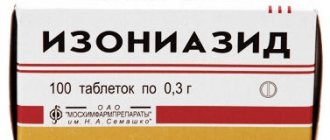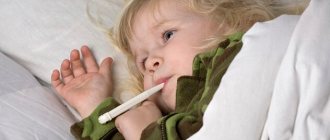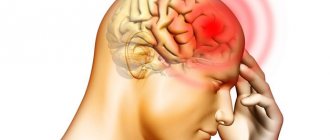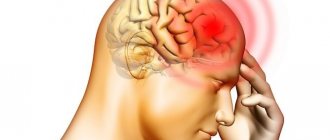Description of the disease
Purulent meningitis in children and adolescents is a serious disease that is accompanied by an inflammatory process in the soft membranes of the brain .
The causative agent is a bacterial infection.
Entering the baby’s body through airborne droplets or through direct contact with a sick person, pathogenic bacteria (streptococcus, meningococcus, pneumococcus) are carried through the bloodstream throughout the body, and with reduced immunity they can cause severe inflammation of the brain.
Purulent meningitis can be caused by bacteria, viruses and sometimes fungus. The difference between this form of the disease and the milder one is that pus accumulates in the sinuses of the soft membranes , which is a constant source of inflammatory processes.
The cause may also be the transfer of infection to brain tissue from foci of purulent otitis or sinusitis.
Today, the disease is extremely rare and almost never ends in death.
Important! If this form of meningitis does begin in a child, and treatment is delayed, then the consequences can be very severe - even disability.
Pathological anatomy
Inflammation of the arachnoid and pia mater is accompanied by the release of exudate, which accumulates under the arachnoid membrane and infiltrates the pia mater. The abundant accumulation of exudate is facilitated by the richness of the soft meninges with blood vessels.
The nature of the exudate appears to be either purulent, sometimes purulent-fibrinous, or predominantly plastic. The degree of virulence of the infection plays a big role, therefore, with lightning-fast leptomeningitis, death can occur before the exudate takes on a plastic character. The amount of purulent exudate can be so great that at autopsy it seems as if the convolutions of the brain are floating in pus. This last circumstance is facilitated by the grooves of the brain, through which larger vessels of the pia mater pass and through which the infection spreads.
Another place for abundant accumulation of exudate is the cisterns at the base of the brain, especially the lateral pontine cistern, located posterior to the apex of the pyramid along the posterior surface of the latter, and the large cistern located between the medulla oblongata and the cerebellum.
In other cases, on the contrary, there is very little exudate; There are even cases when, with undoubted leptomeningitis, the meninges macroscopically appear unchanged.
Due to the accumulation of exudate in the sulci of the brain, hyperemia of blood vessels and swelling of the brain tissue, intracranial pressure increases, which leads to flattening of the cerebral convolutions. There are frequent cases when ulcers form on the surface of the convolutions - abscesses of the cerebral cortex due to the transfer of purulent inflammation from the soft meninges to them. In general, with leptomeningitis, the medulla is always involved in the inflammatory process, therefore, along with meningitis, there is always more or less pronounced encephalitis.
The process spreads through the vessels of the pia mater, which become thrombosed and in which retrograde embolism occurs. Therefore, the process easily passes from one half of the brain to the other, or from one surface to another, or from the brain to the spinal cord.
The degree of severity of pathoanatomical changes in the meninges and brain matter is not, however, in accordance with the clinical picture of the disease. Therefore, sometimes with a mild clinical course, severe pathological changes are found and vice versa.
Leptomeningitis begins in the middle cranial fossa when the process moves to the meninges from the side of the tegmen tympani et antri and in the back - when moving from the side of the labyrinth.
Classification
According to severity, the disease is divided into the following forms:
- light;
- medium-heavy;
- heavy.
In a mild form the clinical picture is mild and there are no severe neurological manifestations. The disease is cured completely, without consequences for the patient.
The moderate form requires long-term hospital treatment and is a form of advanced meningitis.
Severe forms of the disease are most often observed against the background of a severe decrease in immunity in young patients, as well as during secondary infection.
Incubation period
The time from the moment of penetration of pathogenic microflora into the child’s body until the appearance of the first symptoms of the disease is considered the incubation period.
In the case of purulent meningitis, the incubation period can range from several hours to 3-4 days .
Depending on the duration of this period, one can judge the severity of the pathology; the shorter the incubation period, the more severe the course of the disease will be.
Clinical recommendations for the diagnosis and treatment of mouse fever in children can be found on our website.
Features of the flow
According to the characteristics of development and course, purulent meningitis develops as:
- Spicy. The most common type, it can be treated without consequences if left untreated;
- Abortive. It is characterized by the absence of typical signs of meningitis, and its clinical manifestations are similar to simple food poisoning; difficult to diagnose at an early stage;
- Fulminant - requires immediate treatment, often characterized by a rapid increase in cerebral edema, leading to loss of consciousness;
- Recurrent is a type of complication of the acute form of purulent meningitis. This form may appear when treatment for the disease begins late, as well as when there is a long-standing source of infection in the body.
In any case, if there are even mild clinical symptoms typical of the disease, it is necessary to immediately show the child to the doctor and undergo all the necessary tests.
Complications and consequences
With timely treatment, complications and dangerous consequences occur only in 2% of cases .
Such complications include:
- tendency to develop migraines;
- epileptic seizures;
- memory impairment;
- disruptions in the functioning of the nervous system;
- involuntary contractions of muscle tissue in certain parts of the body;
- decrease or loss of vision, hearing;
- mental retardation, behavioral disorders;
- kidney dysfunction;
- movement disorders;
- cerebral edema;
- intoxication of the body.
How does laryngitis manifest in a baby? Find out the answer right now.
Main reasons
Purulent meningitis always occurs as a result of infection of the baby with pathogenic microorganisms.
The infection is transmitted by airborne droplets from person to person. One sick child can infect a large number of classmates or friends in the kindergarten group.
But it is not at all necessary that someone who has been in contact with the source of infection will definitely get sick. There are several risk factors that increase the likelihood of infection. These include:
- weakened immunity due to persistent viral diseases;
- severe and prolonged hypothermia ;
- stress related to study or the family situation, emotional outbursts (for example, before exams or going to a new kindergarten);
- early consumption of alcoholic beverages and cigarettes ;
- recent traumatic brain injury .
Important! In newborns, the cause of the disease is most often E. coli.
Complaints and manifestations
Symptoms of the disease in children and adults manifest themselves in the form of weakness, cough, runny nose, diarrhea and vomiting, skin rashes; if purulent meningitis occurs as a result of other diseases, then weakness, drowsiness, pain above the eyebrows or under the eyes, fever, pain in the bones are noted.
Children under 3 years of age have characteristic symptoms:
- during sleep, he reaches his hands to his head, it is difficult to wake him up;
- the fontanel tenses and protrudes above the cranial bones or sinks;
- the child moans, does not go into his arms, cries monotonously;
- a sick baby does not sleep well, convulsions may occur during sleep or skin rashes may occur;
- the child tries to lie with his legs tucked on his side and his head thrown back.
Before meningitis, the child often suffers from otitis media, pneumonia, and bronchitis.
In adults, the symptoms of purulent meningitis are somewhat different. Here it appears:
- severe headache;
- photophobia, dizziness, weakness;
- heat;
- inability to bend your head;
- inability to stretch your legs at the knees;
- flexion of the hip and knee joints not controlled by the patient;
- vomit;
- red rash on the body;
- difficulties in orientation, hallucinations and coma;
- damage to joints and some internal organs - stomach, kidneys, bladder.
If these signs are detected, especially in young children, you should immediately call an ambulance to hospitalize the patient in a hospital for immediate assistance.
Symptoms
The disease is usually characterized by the following symptoms:
- rapid rise in body temperature to 39-40 degrees;
- severe chills - the child is shaking, often he cannot even speak normally because his teeth are chattering;
- nausea and vomiting;
- headache , the intensity of which increases every hour.
If the baby is not immediately sent to the hospital and treated, more severe symptoms may occur, such as:
- impaired visual perception - a small patient will have double vision, visual acuity will decrease;
- the child may complain of spots before the eyes , partial loss of peripheral vision;
- decreased hearing acuity.
Additional complications include partial memory loss, hallucinations, often disturbing and painful, confusion and even speech impairment.
Useful video on the topic:
Assistance in a medical facility
The main method of diagnosis in adults and children is the examination of cerebrospinal fluid, for which a puncture is performed. Computed tomography, ultrasound of the head, and MRI are also performed - intended for differential diagnosis of meningitis from tumors, abscesses, encephalitis, and strokes.
Secondary meningitis can be detected by congestion in the fundus. In children, in addition to taking a puncture, blood is taken for analysis - a large number of leukocytes and neutrophils determines an accurate diagnosis.
Treatment of severe forms of purulent meningitis is carried out only in a hospital. If the baby’s disease is mild, it can be treated at home. Adults are treated only in a hospital. The main goal in the treatment of purulent meningitis is timely hospitalization of the patient and the selection of the correct methods of therapy.
The outcome of the disease depends on how timely therapy is started. When hospitalized, it is important to identify the source and cause of infection in order to prescribe effective medications.
Traditional medicine
Treatment of purulent meningitis in both adults and children begins as soon as the doctor suspects an inflammatory process in the brain. To begin therapy, a broad-spectrum antibiotic is administered, after which the patient is hospitalized. While the diagnosis is being carried out, the patient continues to be given antibiotics. Having established an accurate diagnosis, treatment is prescribed.
Therapy involves the use of antibiotics from the cephalosporin, penicillin and macrolide groups. They are administered in the maximum permissible doses, every 4 hours, and after a noticeable improvement, treatment with antibiotics continues for up to a month.
Other medications are also prescribed to relieve unpleasant symptoms:
- stop vomiting and relieve nausea - Cerucal;
- Baralgin or Ketanol will help relieve headaches
- eliminate intoxication and prevent dehydration - sodium chloride solution, glucose, osmotic compounds;
- prevent cerebral edema .
For purulent meningitis, a craniotomy is performed to remove the pus. If this is a secondary form of the disorder, then medications are prescribed to treat the underlying disease.
After improvement of health, the patient is sent for home treatment and subsequent dispensary observation.
Children are observed by a pediatrician, infectious disease specialist and neurologist for 2 years with regular examinations, first every 3 months, then once every six months. After discharge from the hospital, adults are observed by a therapist, neurologist, infectious disease specialist and psychiatrist for two years.
For the first 3 months, the patient must visit specialists 2 times a month, and then once every three months. In the second year of observation, one visit to doctors every six months is sufficient. The terms are valid in the absence of deterioration in health.
ethnoscience
Traditional methods of treatment help alleviate the patient’s condition, but do not help cure the disease itself. Apply:
- An infusion of thistle herb is good for relieving cramps.
- Chamomile tea helps the patient relieve stress and calm down .
- Lavender infusion relieves cramps and is a diuretic : 3 teaspoons of dried flowers in 2 cups of boiled water, leave for 30 minutes.
- A collection of lavender flowers, primrose and valerian roots, mint and rosemary leaves, taken 20 g each and poured with a glass of boiling water, will help relieve irritation and headaches Drink 500 ml per day of this infusion after cooling and filtering.
At home, before the ambulance arrives, the patient must be provided with mental and physical peace. Close the windows with curtains so that the light does not intensify the headache and does not blind the eyes, and ensure silence.
Place ice or rags soaked in cold water on your head, arms to the elbows and legs to the knees, along the spine and change them as you warm up. You can give the patient a headache medication.
Diagnostics
To make a diagnosis, the doctor relies on the clinical manifestations of the pathology. In addition, to accurately diagnose the pathogen and identify the stage of the disease, studies such as:
- blood test - general and biochemical;
- cerebrospinal fluid puncture;
- x-ray;
- Ultrasound and CT scan of the brain.
In some cases, if the baby has a rash, a scraping from it is also sent for analysis.
Consequences of purulent meningitis
The consequences of this disease in children include:
edema and swelling of the brain matter with the development of wedging of the brain into the foramen magnum of the base of the skull;- septic complications;
- multiple organ failure;
- development of endocarditis;
- empyema of the dura mater;
- development of sensorineural hearing loss;
- epileptic syndrome;
- coma and death.
Features of treatment
It is necessary to start therapy as soon as the baby has the first clinical symptoms.
Important! Do not self-medicate under any circumstances, especially do not give your child antibiotics without a doctor’s prescription!
Treatment of purulent meningitis involves admitting the patient to a hospital and conducting a thorough diagnosis to select the correct treatment.
In some cases, if the baby is in critical condition, he may need to be hospitalized in the intensive care unit. There he will be given IV drips with the necessary medications to relieve acute symptoms.
For treatment, the doctor will prescribe the following groups of drugs:
- diuretics. They are needed to prevent cerebral edema and fluid stagnation in the body of a small patient;
- sodium bicarbonate (medicinal soda) in special ampoules;
- antiemetics;
- medications to improve blood microcirculation ;
- anticonvulsants.
The most important thing to treat meningitis is to take antibiotics. The type of antibacterial agent depends on what pathogen caused the disease. If the symptoms are acute and there is no time for laboratory diagnostics, the doctor will first prescribe broad-spectrum antibiotics.
Prevention
- Vaccination against meningococcal meningitis, Haemophilus influenzae and pneumococcal infections.
- Compliance with personal hygiene measures;
- Adequate treatment of infections, especially respiratory ones (prevention of secondary purulent meningitis);
- At the first suspicious symptoms of purulent meningitis, immediately seek medical help;
- Prompt isolation of the patient upon diagnosis (prevention of the spread of meningitis).
Video from YouTube on the topic of the article:









